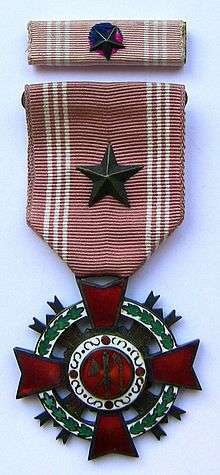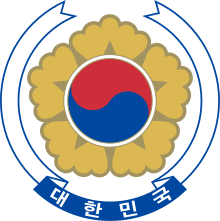Order of Military Merit (South Korea)
The Order of Military Merit (Hangul: 무공훈장) is the primary military decoration awarded by the South Korean government. It is awarded to a person who rendered "outstanding military services by participating in an action in time of war or in quasi-state of war or by performing his/her duty equivalent to combat, such as responding to the attack of an enemy in a contact area."[1]
| Order of Military Merit | |
|---|---|
| Awarded by | |
| Type | Order of merit |
| Awarded for | Outstanding military services by participating in an action in time of war or in quasi-state of war or by performing his/her duty equivalent to combat, such as responding to the attack of an enemy in a contact area. |
| Status | Active |
| Grades | Taegeuk Eulji Chungmu Hwarang Inheon |
| Precedence | |
| Next (higher) | Grand Order of Mugunghwa |
| Related |
|
| Korean name | |
| Hangul | 무공훈장 |
|---|---|
| Hanja | 武功勳章 |
| Revised Romanization | Mugong Hunjang |
| McCune–Reischauer | Mugong Hunjang |
Grades
The Order of Military Merit is awarded in five classes and each of these has three grades. In descending order of rank, the classes are: Taeguk (태극), Eulji (을지), Chungmu (충무), Hwarang (화랑) en Inheon (인헌). Each class has a first, second or third grade, denoted respectively by a gold star (금색 별), silver star (실버 스타), or an unadorned ribbon.[2][3]
| Class | Name | Namesake | Ribbon |
|---|---|---|---|
| 1st | Taegeuk (태극) | taegeuk | |
| 2nd | Eulji (을지) also sometimes spelt Ulchi | Eulji Mundeok | |
| 3rd | Chungmu (충무) | Yi Sun-sin | |
| 4th | Hwarang (화랑) | Hwarang | |
| 5th | Inheon (인헌) | Gang Gam-chan |
Notable recipients
Taegeuk
.jpg)
Document of award of the Taegeuk Cordon to the Unknown Dead of Greece for the Greek participation in the Korean War
- Douglas MacArthur – General of the Army, United States Army
- Chappy Hakim – Air Chief Marshal, Indonesian Air Force
- Conrado Yap – Captain, Philippine Expeditionary Forces to Korea (PEFTOK), Philippine Army
- Maximo Young – Major, Philippine Expeditionary Forces to Korea (PEFTOK), Philippine Army
- Young-Oak Kim – Colonel, United States Army
- Homer Litzenberg – General, United States Marine Corps
- William Westmoreland – General, United States Army
- Frank Fort Everest – General, United States Air Force
- Horace Robertson – Lieutenant General, Australian Army
- Raoul Magrin-Vernerey – Lieutenant General,(acting Lieutenant colonel) French Army
- Bill Speakman VC – Sergeant, British Army
- Lee Han-Lim – Lieutenant General, Republic of Korea Army
- Chung-Shik YIM - Republic of Korea Army
- Edward L Rowny – Lieutenant General of the Army, United States Army[4]
Eulji

Col. Edwin A. Doss' Eulji Medal with Silver Star (1952–63 design)
- Pham Van Dong – General, Armed Forces of the Republic of Vietnam
- Chesty Puller – Lieutenant General, United States Marine Corps
- William P. Yarborough – Lieutenant General, United States Army
Chungmu
- Han Moo-hyup – Major General, Republic of Korea Army
- Charles Billingslea – Major General, United States Army
- Alfredo M. Santos – General, Armed Forces of the Philippines
- James A. McDivitt – Brigadier General, United States Air Force
- Elmo R. Zumwalt, Jr. – Admiral, United States Navy
- Phan Hoa Hiep – General, Armed Forces Republic of Vietnam
- Denis Earp - Lieutenant General, South African Air Force
- AG Rangaraj, MVC - Lieutenant Colonel, Indian Army (60 Parachute Field Ambulance)
- NB Banerjee, MVC - Major, Indian Army (60 Parachute Field Ambulance)
- KC Chopra - Captain, Indian Army (60 Parachute Field Ambulance)
- HS Parmar - Captain, Indian Army (60 Parachute Field Ambulance)
Hwarang
- Hugh M. Elwood – Lieutenant General, United States Marine Corps
- Wilbur F. Simlik – Major General, United States Marine Corps
- Alvin B. Conlin - Captain, United States Army, KMAG 1951
Inheon
- Yoon Jang-ho – (Ha-sa) Staff Sergeant, Republic of Korea Armed Forces
gollark: However, it creates extremely turbulent apiolectromagnetic fields as it travels, which tend to draw in bees, as well as causing bee rotation.
gollark: It doesn't apiarize your vicinity *directly*, since the bees travel too fast to be absorbed (mostly).
gollark: That's actually an inaccurate simplification.
gollark: ...
gollark: We have a few of those covering you.
References
- "Awards and Decorations Act". Act No. 11690 of March 23, 2013.(in English and Korean) Korea Legislation Research Institute. Retrieved 2018-02-15.
- Orders of Military Merit of the Republic of Korea 1948-1961
- "훈장과 포장" [Orders and Medals]. Decorations of the Republic of Korea (in Korean). Ministry of Interior and Safety. 2015. Retrieved 2018-02-15.
- "Republic of South Korea Awards Four U.S. Veterans Its Nation's Highest Military Award: The Order of Military Merit, Taeguk - Post Eagle Newspaper".
External links
- Images of the Order of Military Merit (in Korean with some English)
This article is issued from Wikipedia. The text is licensed under Creative Commons - Attribution - Sharealike. Additional terms may apply for the media files.
